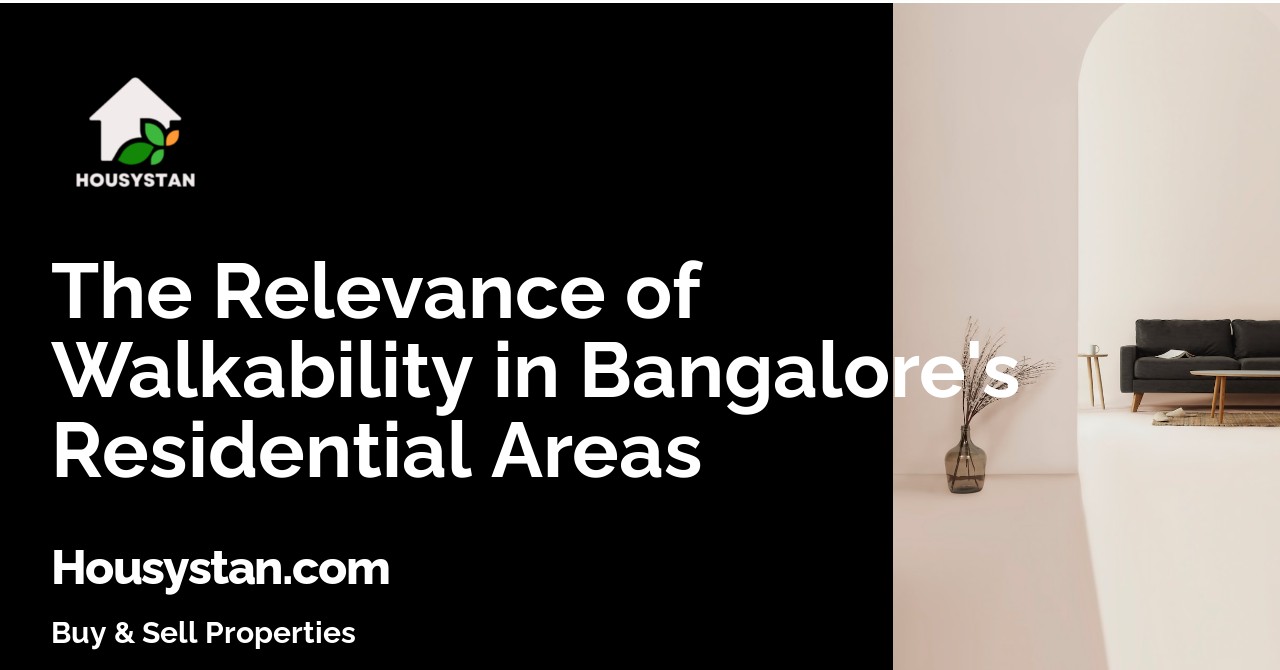The Relevance of Walkability in Bangalore's Residential Areas
Read latest blogs and articles from Housystan

The Information mentioned here was last updated on:
14/12/2025The Buzz About Walkability: What It Means for Bangalore's Residential Areas
Bangalore, known as India's Silicon Valley, is a city bursting with growth, innovation, and a vibrant community. Yet, amidst the rapid urban development, one factor often overlooked is walkability. The term "walkability" refers to how friendly an area is for walking, an aspect of urban design that holds the key to healthier lifestyles, safer streets, and a more connected community. Let's explore how walkability is shaping Bangalore's residential areas and why it matters now more than ever.
Understanding Walkability
- Verified Tenants/Buyers
- Unlimited Property Listing
- Zero subscription/charges fee
Walkability goes beyond the simple presence of sidewalks. It involves:
- Proximity to Amenities: How close essential services like grocery stores, schools, and hospitals are.
- Safety and Accessibility: Presence of pedestrian crossings, ramps, and proper lighting.
- Quality of Pathways: Availability of wide, well-maintained sidewalks free of obstructions.
- Aesthetic Value: Green spaces, public art, and well-planned streetscapes that enhance the walking experience.
For Bangalore, a city challenged by traffic congestion and pollution, improving walkability can lead to significant lifestyle improvements.
The Benefits of a Walkable Bangalore
Promotes Health and Well-being
Being more walkable can directly contribute to the physical and mental health of residents:
- Physical Activity: Regular walking reduces the risk of chronic diseases such as obesity, heart disease, and diabetes.
- Mental Health: Walking can alleviate symptoms of depression and anxiety by reducing stress and stimulating endorphin production.
Reduces Traffic Congestion
With thousands of vehicles added to Bangalore's roads every month, traffic congestion has become a severe issue. Greater walkability provides alternative commuting options:
- Public Transit Access: Easy access to bus stops and metro stations reduces dependency on private vehicles.
- Reduced Travel Times: Walking can be faster and more convenient than driving, especially for short distances.
Environmental Impact
A walkable neighborhood can significantly lessen the environmental footprint:
- Lower Carbon Emissions: Fewer cars on the road mean reduced greenhouse gas emissions.
- Improved Air Quality: Dense greenery and less vehicular traffic improve air quality, crucial in combating Bangalore's air pollution.
Key Areas in Bangalore Leading the Walkability Charge
Several residential areas in Bangalore are setting benchmarks in terms of walkability:
- Whitefield: This tech hub has been steadily investing in pedestrian infrastructure, making it easier for residents to walk or cycle to work and amenities.
- Indiranagar: Known for its vibrant lifestyle and accessibility, Indiranagar boasts wide pavements and interconnected streets.
- Jayanagar: One of Bangalore's oldest localities, Jayanagar is renowned for its well-structured layout and walk-friendly roads and parks.
Challenges to Improving Walkability
While the concept of walkability sounds promising, Bangalore faces several challenges in implementing these ideas:
Infrastructure Limitations
- Inadequate Sidewalks: Many areas lack sidewalks or have poorly maintained paths.
- Blocked Pathways: Encroachments and illegal street vendors often obstruct walkways.
Safety Concerns
- Traffic Violations: Jaywalking and lack of pedestrian crossings increase accident risks.
- Security Issues: Poor lighting and isolated areas deter people from walking, especially after dark.
Urban Planning Challenges
- Zoning Issues: Unplanned urban sprawl disrupts residential layouts, diminishing walkability.
- Budget Constraints: Investments in pedestrian infrastructure compete with other urban development needs.
Steps Towards a More Walkable Bangalore
Making Bangalore more walkable requires a concerted effort from local authorities, urban planners, and the community. Some strategies include:
Policy Improvements and Investments
- Government Initiatives: Programs like TenderSURE aim to rebuild roads from the ground up, improving pedestrian infrastructure.
- Public-Private Partnerships: Encouraging collaboration between city planners and private entities for better urban design solutions.
Community Involvement
- Resident Associations: Advocacy for smoother pedestrian access and better infrastructure maintenance.
- Volunteering and Awareness: Citizens organizing events to raise awareness about the importance of walkability.
Technological Integration
- Smart City Solutions: Utilizing technology to identify high foot-traffic areas and plan accordingly.
- Mobile Applications: Apps that help residents choose the safest and most efficient walking routes can also increase walkability.
Internal Linking Opportunities
While discussing walkability, it is essential to highlight interconnected topics that contribute to understanding the broader picture. Consider linking to articles on:
- Urban Development in Bangalore: Explore how walkability fits into larger urban planning initiatives.
- Health Benefits of Walking: A deeper dive into how walking impacts health, providing actionable tips for incorporating walking into daily life.
- India's Smart City Mission: Insights into how India's broader urban initiatives are paving the way for smarter, more sustainable cities.
Emphasizing walkability can redefine the urban landscape of Bangalore, making it not just an economic powerhouse, but also a model for sustainable, healthy living. Focusing on these aspects will not only boost the city's livability but also set a precedent for other growing metropolises across the nation.